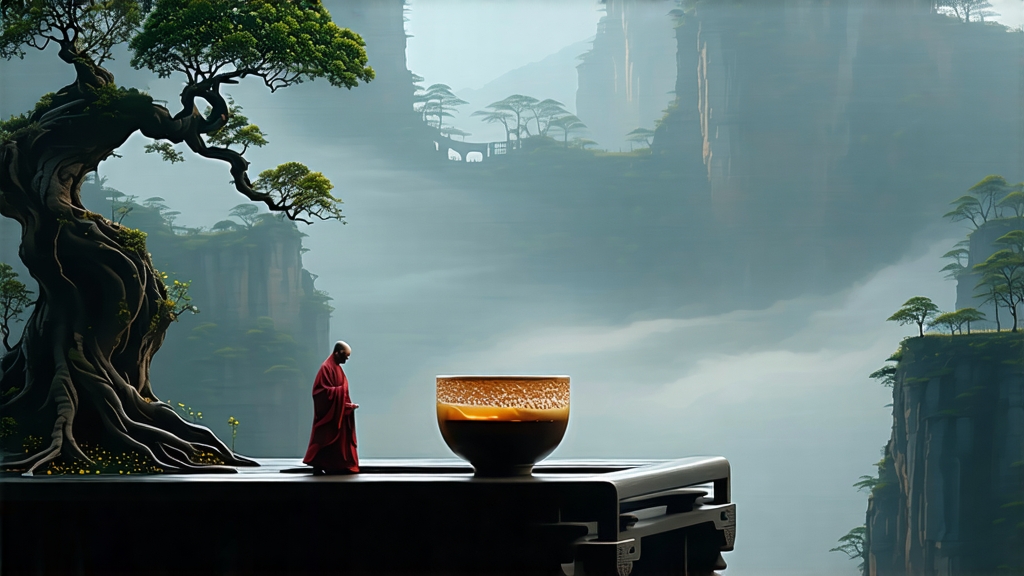
If green tea is the fresh-faced youth of Chinese tea and pu-erh the wise elder, then Da Hong Pao sits between them like a meditative warrior-poet—muscular yet graceful, forged by fire yet fragrant with flowers. Known in the West as “Big Red Robe,” this most celebrated oolong carries the mineral soul of Wuyi’s granite cliffs and the incense of centuries-old charcoal kilns. To drink it is to taste China’s Song-dynasty landscape paintings dissolved in liquid amber.
Origin Myth and Imperial Robes
Legend says a Ming-dynasty scholar, on his way to the capital for imperial exams, fell ill near the Wuyi Mountains. Monks from Tianxin Temple brewed leaves plucked from six bushy old trees clinging to a narrow rock crevice; the scholar revived, passed the exams with highest honors, and returned in gratitude draped in the scarlet robe awarded by the emperor. He draped the robe over the tea trees, proclaiming, “Your virtue saved me; may this crimson cloak guard you.” Whether myth or marketing, the name stuck, and the mother trees—still alive on Jiulongke cliff—became living national treasures. Cuttings from them spread across the Wuyi range, giving birth to what connoisseurs call “pure pedigree” or qizhong Da Hong Pao.
Terroir: When Granite Breathes
The Wuyi range, a UNESCO World Heritage site, is a 650-million-year-old spine of volcanic rock eroded into gorges so narrow that locals call them “thread of sky.” Daytime heat stored in the cliffs radiates back at night, creating a 10 °C diurnal swing that forces the tea leaves to thicken their cell walls, concentrating aromatic oils. Frequent mist filters sunlight into a soft, diffused glow; the tea bushes, mostly of the resilient Shuixian and Qidan cultivars, respond by producing more amino acids and floral volatiles. The result is yan yun—literally “rock rhyme”—a tactile minerality that Chinese drinkers describe as the sensation of licking a wet stone, followed by a lingering coolness like mint without mint.
Craft: The Dance of Fire and Time
Da Hong Pao is the most labor-intensive tea in China. Picking occurs only in late April, when three half-open leaves atop each shoot form the ideal “dragonfly head” pluck. The leaves are first withered on bamboo racks set inside the cave-like mouth of the cliff, where mountain breezes carry the scent of orchids and pine. Once supple, they are shaken in flat wicker trays—a process called yao qing—to bruise the edges against the veins, initiating partial oxidation. Masters listen for a faint rustle compared to “the wing beat of a dragonfly,” the audible cue that cell walls have cracked just enough. Oxidation is arrested at roughly 40 % by a 280 °C tumble in electric woks, hotter than those used for green tea yet cooler than for black, preserving the jade center while bronzing the rim.
What follows is the signature Wuyi charcoal roast. The semi-fermented leaves are loaded into bamboo baskets nested over a pit of glowing lychee-wood embers whose steady 80 °C heat perfumes the leaf for eight to twelve hours. The tea is allowed to rest for forty days, then roasted again—some premium lots see three cycles across half a year. Each roast drives moisture from the core while caramelizing sugars, building layers of cocoa, toasted almond and pipe tobacco that balance the upfront florals. When done correctly the leaf acquires a beguiling shimmer, as though dusted with iron-ore flecks from the mountain itself.
Grades and Lineage
Government standards divide commercial Da Hong Pao into three tiers:
- Mother-Tree Grade—harvested before 2006 when picking was banned; existing stocks auction for over US$10,000 per gram.
- Pure-Pedigree (qizong)—cloned directly from the mother trees and grown within the 60 km² core scenic zone; about 2,000 kg exist yearly.
- Blended (peifang)—majority Shuixian or Qidan base scented with a small percentage of pedigree leaf; accounts for 98 % of the market.
A separate niche is “old-bush” Da Hong Pao: trees 30–80 years old rooted in tiny